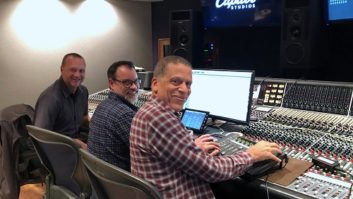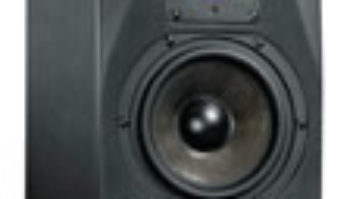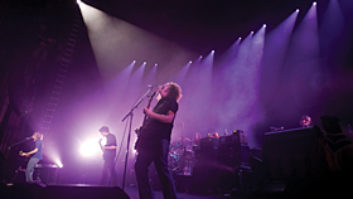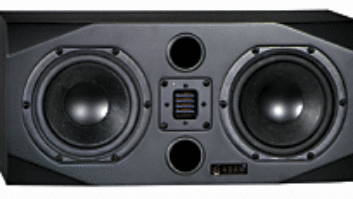The Alesis M1 Active Reference Monitors ($649/pair) are compact, bi-amped monitors with mirror image design. The low-frequency section consists of a 75-watt amp (.03% THD @ 30 watts/8 ohms) pushing the 6.5-inch (165mm) dynamic driver with a non-woven carbon fiber cone and 1.5-inch voice coil. Maximum SPL is greater than 118 dB at one meter. Rated response is 50 to 20k Hz, +/-2dB, with 38Hz and 23.5kHz-10dB down points. And for those who need more bottom end, the Alesis S1 Active(tm) subwoofer ($599) adds an 8-inch LF driver pushed by 250 watts, for response down to 40 Hz (+/-2 dB).
A dual-magnetic structure with opposing magnets is used for magnetic shielding. The 25-watt HF amp (.06% THD @ rated power) pushes the 1-inch silk dome tweeter, which is cupped in low-carbon steel to reduce magnetic interference. To test for magnetic interference, I placed the M1s less than an inch from either side of my DAW monitor; I saw no color or shape distortion at all.
The back of each monitor has an IEC power cord receptacle, on/off switch, a center-detented 28dB sensitivity trim pot and a Neutrik 11/44-inch/XLR Combo jack. There are no other adjustments. Alesis uses a regulated switching power supply for the amps. The manual suggests that fuses or breakers have not been included because Pulse Width Modulation (PWM) makes them unnecessary. The manual also suggests setting up the monitors with the offset HF drivers positioned on the inside rather than outside. I tried it both ways-the manual is right. Placing the drivers to the outside was very distracting. I also found that having them exactly at ear level was better than having them a bit above or below.
STUFF A SOCK IN IT
Although the M1 is without active (or passive) electronic controls for altering its frequency response, the manual suggests that stuffing the two ports with wads of cloth will reduce the LF response. Because the M1s never exhibited too much bottom end, I chose not to exercise that feature. The ports are also designed to push air over the warmer parts of the internal power amps, to keep them cool. The back plate of the M1 runs slightly warm, but a lot cooler than some smaller powered monitors I’ve recently been around.
I was joined by Brian Glock for our first session. The monitors were placed, tweeters-in, on top of a pair of Electro-Voice Sentry 100A monitors in the typical triangle about 4.5 feet apart, and we were about four feet from each monitor. After plugging in and firing up the M1s, we listened to an HHB CDR-800 CD burner through a Mackie 1604, with Steely Dan’s Aja as the test material. The M1 sounded bright and edgy. When the sax solo on “Black Cow” came up, Brian and I looked at each other and simultaneously said, “Listening fatigue.”
The Sentry 100As, powered by a Hafler P4000, were much more pleasant, with a more present midrange and without the edge. The M1s’ lack of midrange made them sound like they were sort of in the next room. We decided to go get something to eat and left Aja playing at a modest level to see if the M1s would loosen up a bit over time. When we came back several hours later, the M1s sounded noticeably less edgy. The M1s had about 10 to 12 hours of break-in before our main event on a fresh morning at Sheffield Audio/Video, just outside Baltimore.
A hat tip to Sheffield engineer Bill Mueller, who also runs the Sheffield Institute Audio Recording curriculum, for hosting the session. We were joined by Racetrack Music Group’s Sal Chandon and Paul Chiacchierini. We spent the better part of the morning making sure everything was as “real” and fair as possible. In the end, we came away with the impression that the M1s were a bit scooped in the mids and sounded a bit farther away compared to Genelec 1031s and Mackie HR824s, but felt that for the price, and considering the competition, they did very well. As an afterthought, we also listened to a pair of Yamaha NS-10Ms powered by a Yamaha P2075 amp. Here the NS-10Ms brought the midrange out front, way beyond that of anything else on the shelf.
To get a more thorough sense of the working ability of the M1, I continued using them back at my studio, listening to a variety of audio ranging from voice tracks for TV spots, mixed radio spots, a wide spectrum of jazz on vinyl and CD for a syndicated jazz show I’m producing, and some CD tracks from the Eagles, Stones, Yes and Van Morrison. The upper bass and midrange did fill in at about 20 hours, but the sound always seemed just slightly farther away and there was always a bit of an edge, regardless of the source. Dealing with the sound appearing to be slightly farther away was easy; I turned the monitors up.
I subsequently learned from Alesis designer Pat Hart that the M1s should undergo a 20-hour burn-in, which loosens the suspension and drops the resonance to about 42 Hz. After these discussions concerning the break-in period, I continued listening with another pair of M1s. I tested these at my studio with a new Mackie 1604 VLZ/XDR mixer and the same pair of EV Sentry 100As, and at Brian Glock’s studio with Event 20/20bas powered monitors.
In my studio, we set the monitors on a board covering my existing custom steel frame supports so they would be on the same lateral axis. Both the EV and Alesis monitors were set up vertically, with the tweeters on top, at ear level and toed in slightly with their faces on the same plane. The Sentry 100s have in-line placement of the LF and HF drivers. The M1 drivers are offset. We placed them with tweeters “in” as recommended by Alesis.
Instantly we noticed that the M1s were not as edgy as before, and the midrange dip was not as apparent. In fact, on “Black Cow,” the vocals and sax were now very clear, more focused and more apparent than on the Sentry 100s.
On the Yes tune “Owner of a Lonely Heart,” the mid-bass or low-mid of the Sentry 100s was warmer and more apparent than on the M1s. On the mono Stones tune “The Last Time,” the focus of the M1s resulted in a much clearer sound, and no sense of scooped mids. It was about at this point that the differences in sound brought my attention to the different materials used in the LF drivers. I think one of the main differences in the signature sound of the two monitors is the Sentry’s paper woofer and the M1’s non-woven carbon fiber. Think about how differently a Martin guitar and an Ovation guitar sound. It was that sort of difference, sort of.
SATURDAY NIGHT FERVOR
We broke for an hour or so, enjoyed a shrimp scampi dinner and reconvened at Brian’s studio to compare the M1s with his Event 20/20bas. These are bi-amped monitors using an 8-inch, mineral filled, polypropylene LF driver pushed by a 130 watts, and a 25mm silk-dome tweeter pushed by 70 watts. The crossover is set at 2.6 kHz.
The 20/20bas has two EQ adjustments, an HF and LF, which we set to +/-0. On “Black Cow,” the M1s have a nice bite to them, but still sounded a bit scooped in the mids. The 20/20bas sounded more diffuse. On “Owner of a Lonely Heart,” the 20/20bas sounded smeary, the M1 clearer, but more distant. The Stones’ “Last Time” sounded much edgier on the M1 than on the 20/20bas. The bite of the M1 on “Crazy” from the Seal CD brought our attention to the tweeter placement. Again, the 20/20bas were more diffuse, the M1 more focused. Some of Brian’s original synth compositions, recorded and mixed on the Events, also sounded a bit mid-low on the M1. On a compilation CD called Pure Funk, The Commodores’ “Brick House” sounded too full on the mids on the 20/20bas and about right on the M1.
I think the difference in mids may be due to the larger LF driver in the 20/20bas and the fact that the crossovers, while hovering around the midrange, are different. The crossover as published for the 20/20bas is at 2.6 kHz, 1.5 kHz for the M1 and at 2 kHz for the Sentry 100A. If these figures still hold true, that distance or scoop we heard in some of the M1 experiences may be due to frequencies above 1.5 kHz but still in the midrange being handled by the silk-dome tweeter. A typical music track with modest complexity contains a lot of information in the 1kHz to 3kHz range. As such, even minor changes can result in a noticeable difference in the mix.
IN CONCLUSION
For project studio primary monitors, the M1s are a much better choice than the Yamaha NS-10Ms. At $649, the M1s are less than half the price of the Mackie 824s and many times less than the Genelec 1031s, so you might say the comparison was unfair. To me, having the M1s hold up compared to far more expensive studio monitors proves they have a very good price/performance ratio. The blue LED power indicator is pretty cool too.
Alesis, 1633 26th Street, Santa Monica, CA 90404; 310/255-3400; fax 310/255-3401; www.alesis.com
Reach Ty Ford at www.tyford.com.




